Pricing is one of the most crucial factors for any business, including e-commerce and Shopify stores. It’s also really hard to know how to price a product or service you might be selling on Shopify. Setting the right price can be challenging, and it requires careful consideration of several factors.
Key pricing considerations:
- cost of goods/production
- marketing and advertising expenses
- shipping and handling
- competition
- target market
- desired profit margin
- pricing psychology
Pricing Pyschology
One of the most important factors, and one of the easiest for you to control is pricing psychology. Pricing psychology essentially studies how consumers perceive prices and how those perceptions affect their purchasing decisions.
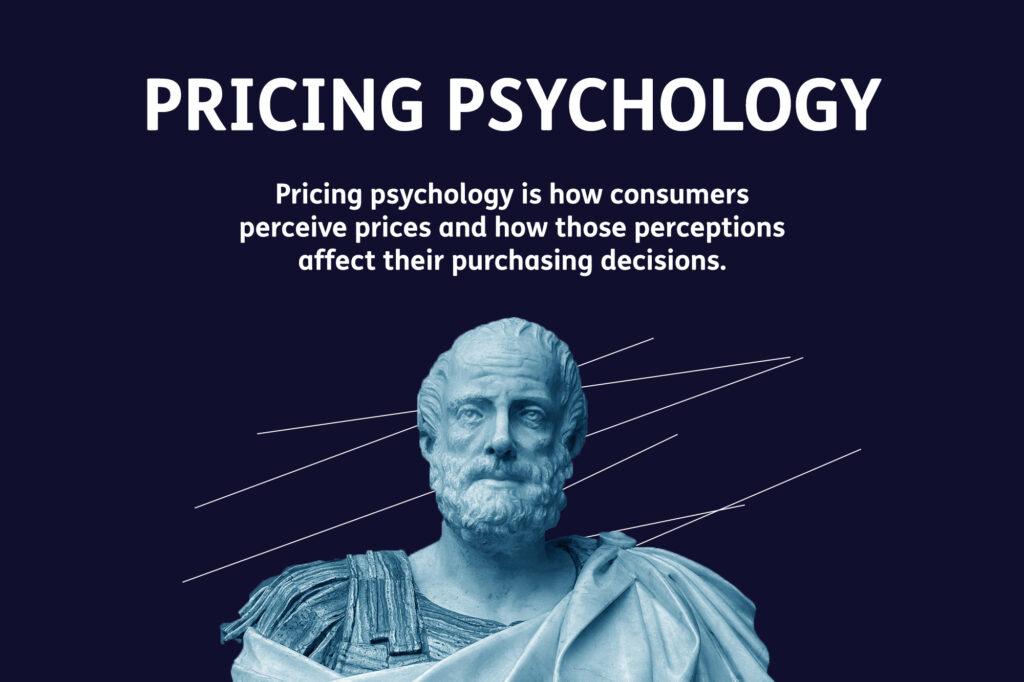
Apart from pricing psychology, other factors that go into pricing include the cost of production, marketing and advertising expenses, competition, target market, and desired profit margin.
11 types of pricing psychology tactics:
- Perception of value
- Anchoring effect
- Importance of Context
- Decoy effect
- Scarcity effect
- Charm pricing
- Odd pricing
- Price bracketing
- Discounts and promotions
- The power of free
- Pay what you want pricing
- Add-On pricing
Perception of Value
Perception of value is a pricing strategy that involves creating a sense of value around a product or service to encourage customers to make a purchase. This strategy is effective because customers are more likely to make a purchase if they perceive the product or service to be valuable.
There are several ways to create a perception of value, including emphasizing the quality of the product or service, highlighting unique features or benefits, and providing excellent customer service. Additionally, presenting prices in a comparison chart can help customers understand the value of a particular product compared to its competitors.
Examples
For example, a Shopify store could create a comparison chart that shows how their product compares to competitors’ products. By presenting the prices of similar products side-by-side, customers can see the value of the Shopify store’s product and how it stacks up against the competition. Additionally, the store could emphasize the unique features or benefits of their product, such as durability or ease of use, to create a sense of value in the customer’s mind.
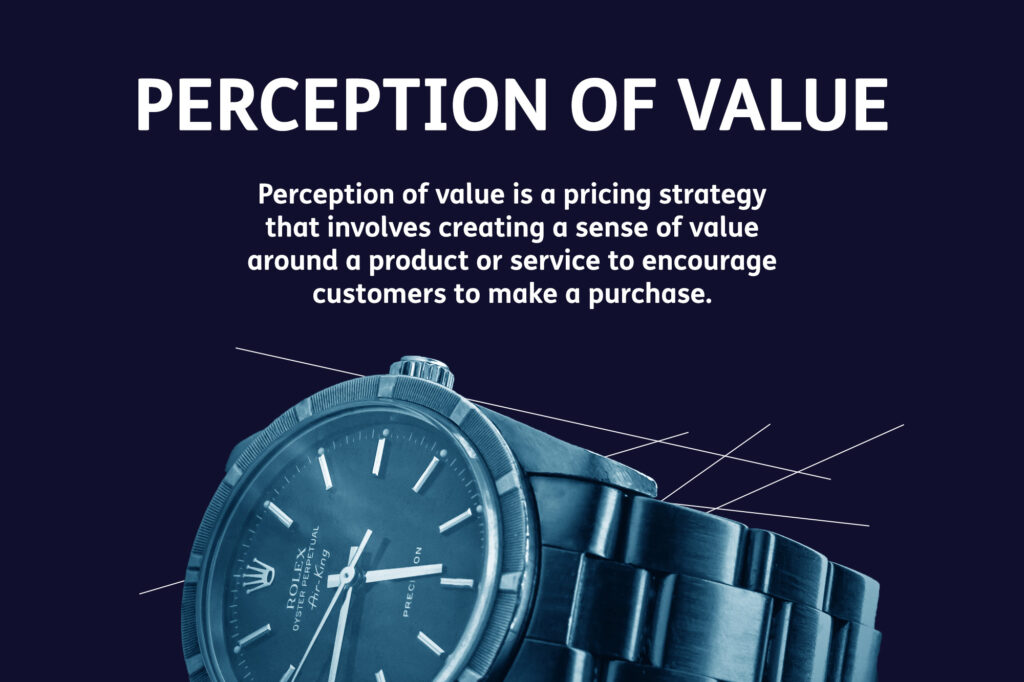
Many luxury companies rely heavily on the perception of value pricing strategy. For example, the luxury brand Louis Vuitton emphasizes the high quality of their products and the exclusivity of their brand to create a sense of value in the minds of their customers. By doing this, they can charge premium prices for their products and attract customers who value the prestige and status associated with owning a Louis Vuitton product.
I personally used to work for Starwood Hotels & Resorts and creating an upper upscale perception of value was also a critical part of our strategy in marketing our hotel brands.
– John Speed
Other examples of brands who rely heavily on the Perception of Value pricing strategy operate in the luxury space. Their e-commerce store designs are typically driven by a narrative approach promoting a feeling of exclusivity, they include brands like Rolex, Porsche, Burberry, Four Seasons, and Tiffany
Here are two examples of luxury brands who use the perception of value pricing strategy on their websites by Rolex, and Four Seasons.
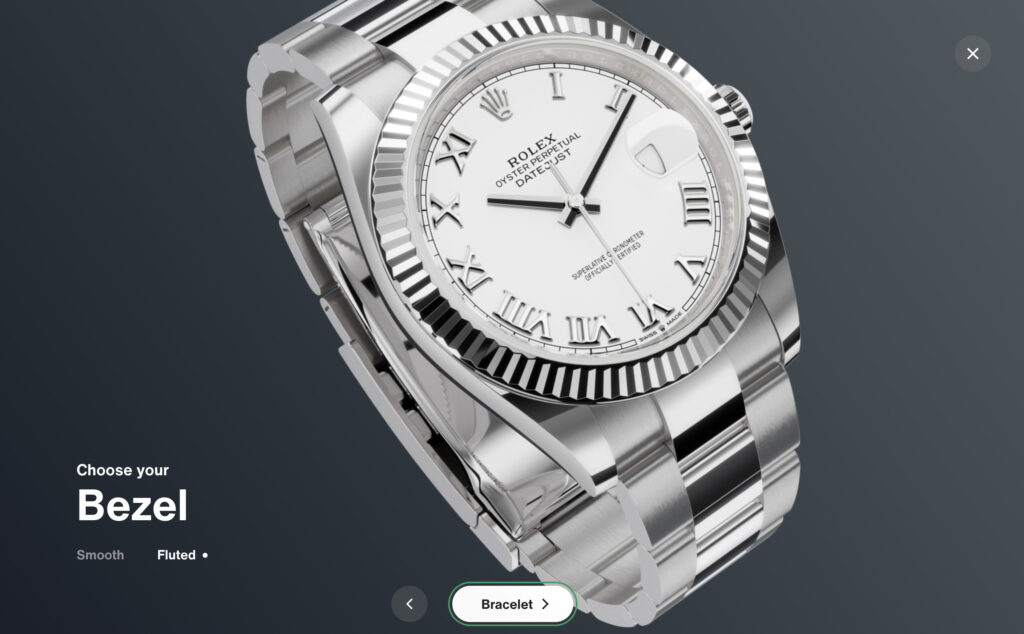
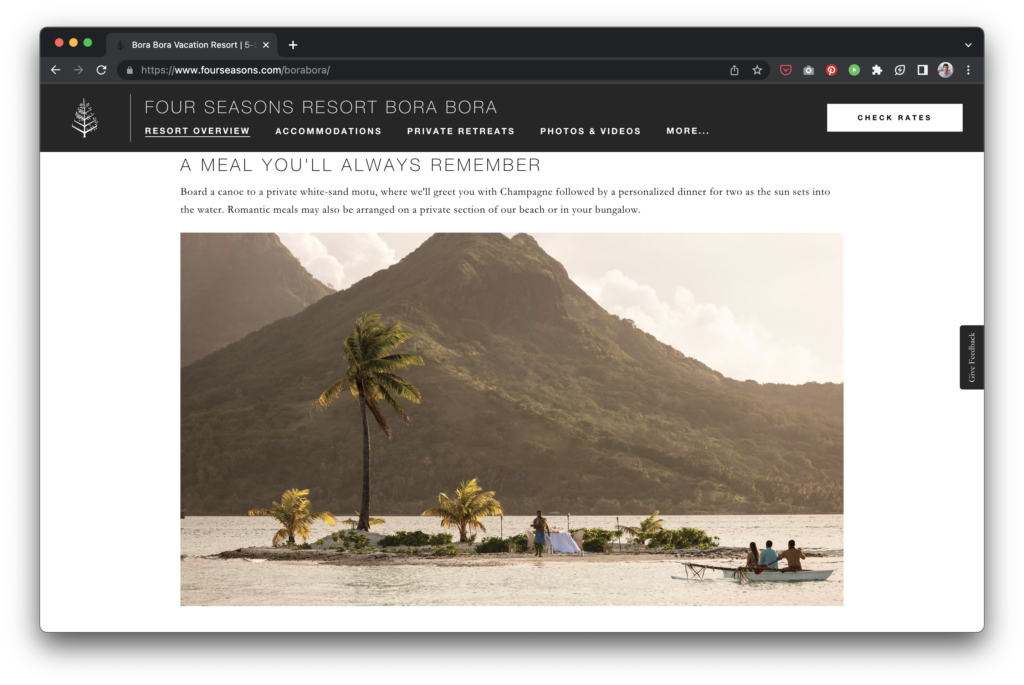
Why use this tactic?
By using the perception of value pricing strategy, a Shopify store can make their product more appealing to customers and increase their chances of making a sale. This can help the store to increase sales and profits, while also building a loyal customer base that values the quality and value of their products or services.
The Anchoring Effect
Another important principle of pricing psychology is the anchoring effect. This effect occurs when consumers use the first piece of information they receive as a reference point for all subsequent information. In the context of e-commerce and Shopify stores, this means that the first price a consumer sees for a particular product can significantly influence their perception of its value.
For example, if a consumer sees a high-priced version of a product before seeing a lower-priced option, they may perceive the lower-priced option as a better value, even if it is still relatively expensive. To take advantage of the anchoring effect, businesses can use a pricing strategy called price bracketing. This involves offering a range of prices for a product or service, with the highest price acting as an anchor for the other prices.
TIP: If you are a Shopify consider raising the price of one of your items to make your other items appear like a better priced option. Ex. If you are selling candles you could purposely choose to make one of the scents ‘exclusive’ and raise the price – this has a psychological impact on buyers and they will be more likely to perceive value in your other candles. This will lead to an increase in sales for your shop.
– John Speed
Examples
A Shopify store could offer a range of products at different price points to take advantage of the anchoring effect.
For example, the store could offer a high-priced product as an anchor, followed by a mid-priced product and a low-priced product. By doing this, the mid-priced product may seem like a better value compared to the high-priced product, and the low-priced product may seem like a great deal compared to both the mid-priced and high-priced products. This can help customers feel like they are getting a good deal and encourage them to make a purchase.
The Importance of Context
Finally, it is essential to consider the context in which prices are presented. For example, consumers may be more likely to pay a premium price for a product if they perceive it as high quality or exclusive. Similarly, presenting prices in a comparison chart can help consumers understand the value of a particular product compared to its competitors.
A Shopify store could offer a comparison chart that shows how their product compares to competitors’ products.
Examples
For example, a Shopify store could offer a 10% discount on a $100 product, making it seem like a great deal compared to similar products on the market. By using these pricing strategies, the Shopify store can make their product more appealing to customers and increase their chances of making a sale.
Why use this tactic?
By presenting the prices of similar products side-by-side, customers can see the value of the Shopify store’s product and how it stacks up against the competition. Additionally, the store could offer a limited-time discount to encourage customers to make a purchase, even if the final price is still higher than the competition.
The Decoy Effect
The decoy effect is a pricing strategy that involves introducing a third option to make one of the other options seem more appealing. This effect can be used in e-commerce and Shopify stores to encourage customers to choose a specific product.
Examples
For example, a business may offer a basic, standard, and premium version of a product.
The standard version may be priced higher than the basic version, but the premium version is priced even higher. This makes the standard version seem like the best value, even if it is still relatively expensive. The decoy effect can be especially effective when the product or service being sold is complex or difficult to understand, as it simplifies the decision-making process for the customer.
Why use this tactic?
By using this pricing strategy, a Shopify store can encourage customers to choose the standard version over the basic version, increasing the store’s profits. This strategy can be especially effective when the product or service being sold is complex or difficult to understand, as it simplifies the decision-making process for the customer.
The Scarcity Effect
The scarcity effect is a super common pricing strategy. It is a pricing strategy that involves creating a sense of urgency or scarcity around a product to encourage customers to make a purchase.
This effect can be used in e-commerce and Shopify stores by offering limited-time promotions or creating a sense of urgency around low stock levels.
Examples
For example, a business may offer a discount on a product for a limited time or advertise that there are only a few items left in stock.
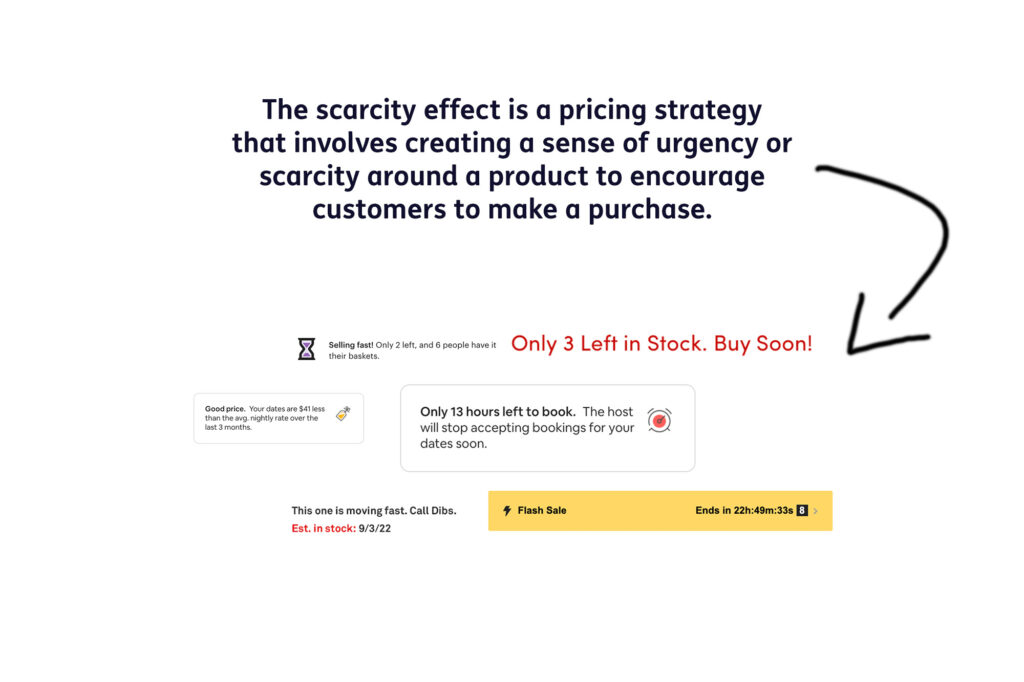
You see it on most sites where e-commerce stores use countdown timers, or countdown tickers to show how popular a product is, and or to show how much inventory is left remaining. Airbnb, Etsy, Ebay and Amazon all use these strategies. These tactics are often used in and around the Add to Cart button on Shopify. If you want to use the scarcity effect for your shop with a sold stock counter, let customers know that items are selling fast you can use an app like Magical Messages.
For example, a Shopify store can offer a limited-time promotion on a product or create a sense of urgency around low stock levels. The store could advertise that there are only a few items of a particular product left in stock or offer a discount on a product for a limited time.
Another example is how many boutique fashion designers and brands employ limited “drops” in order to generate a sense of exclusivity and hype, and ultimately more sales for each of their seasonal releases. In this context, using “whole” prices enhances the sense that the products available are of high value even further.
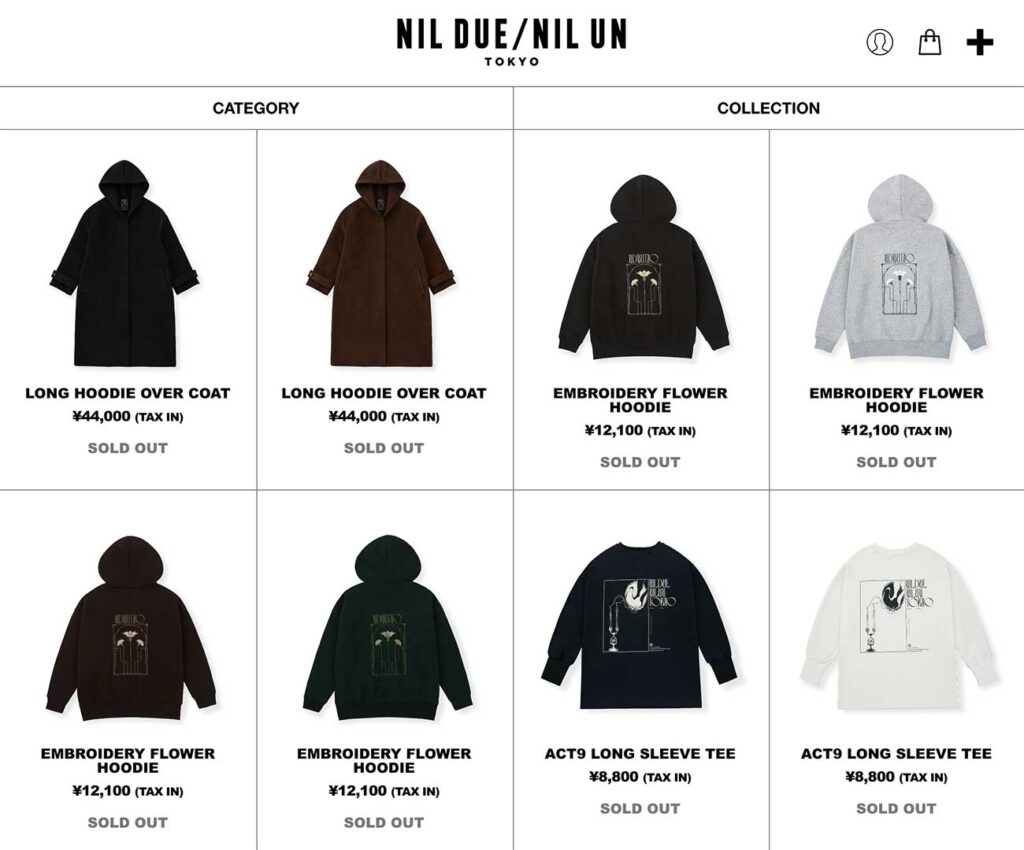
I love Japanese fashion and have often observed how brands like NIL DUE / NIL UN release collections every year. Items are made-to-order, enhancing their exclusivity and urgency to buy.
– Scott Williamson
Why use this tactic?
The Scarcity Effect can create a sense of urgency in customers, making customers more likely to make a purchase before a promotion ends or the product runs out, thus increasing a store’s profits.
Charm Pricing
Psychologists have long studied the impact of numbers on human behavior, and pricing psychology is no exception. One of the most commonly used pricing strategies is ending prices with the number nine.
Examples
For example, setting a price of $9.99 instead of $10.00. This strategy is known as “charm pricing,” and it works because consumers tend to round down the price to the nearest whole number. In other words, they perceive $9.99 as closer to $9 than to $10, which makes the price seem more affordable and appealing.
Charm Pricing is when you set a price of $9.99 instead of $10.00. It works because customers round down the price in their heads making $9.99 feel cheaper than $10.00.
Interestingly, studies have shown that prices ending in odd numbers, such as 9, are more effective in attracting customers than prices ending in even numbers. This is because odd numbers are perceived as more unique and less ordinary, which makes the product or service stand out. Additionally, odd numbers are associated with discounts or bargain prices, which further increases the appeal.
For example, a Shopify store selling a product for $99.99 instead of $100.00 can tap into the charm pricing strategy to make their product seem more affordable and appealing. Additionally, by using odd numbers, such as 99, the store can create a perception of uniqueness and increase the product’s appeal to customers.
Why use this tactic?
By implementing this pricing strategy, the Shopify store can make their product stand out and increase their chances of making a sale.
Odd Pricing
Odd pricing is a pricing strategy that involves ending prices in odd numbers, such as 9, rather than even numbers. This is because odd numbers are perceived as more unique and less ordinary, which makes the product or service stand out. Additionally, odd numbers are associated with discounts or bargain prices, which further increases the appeal.
Examples
For example, a Shopify store selling a product for $99.99 instead of $100.00 can tap into the odd pricing strategy to make their product seem more affordable and appealing. By using odd numbers, such as 99, the store can create a perception of uniqueness and increase the product’s appeal to customers.
Why use this tactic?
By using odd numbers, such as 99, the store can create a perception of uniqueness and increase the product’s appeal to customers.
Price Bracketing
Price bracketing is a pricing strategy that involves offering a range of prices for a product or service, with the highest price acting as an anchor for the other prices.
This strategy takes advantage of the anchoring effect, where consumers use the first piece of information they receive as a reference point for all subsequent information. In the context of e-commerce and Shopify stores, this means that the first price a consumer sees for a particular product can significantly influence their perception of its value.
Examples
For example, a Shopify store could offer a range of products at different price points to take advantage of the anchoring effect. The store could offer a high-priced product as an anchor, followed by a mid-priced product and a low-priced product.
By doing this, the mid-priced product may seem like a better value compared to the high-priced product, and the low-priced product may seem like a great deal compared to both the mid-priced and high-priced products. This can help customers feel like they are getting a good deal and encourage them to make a purchase.
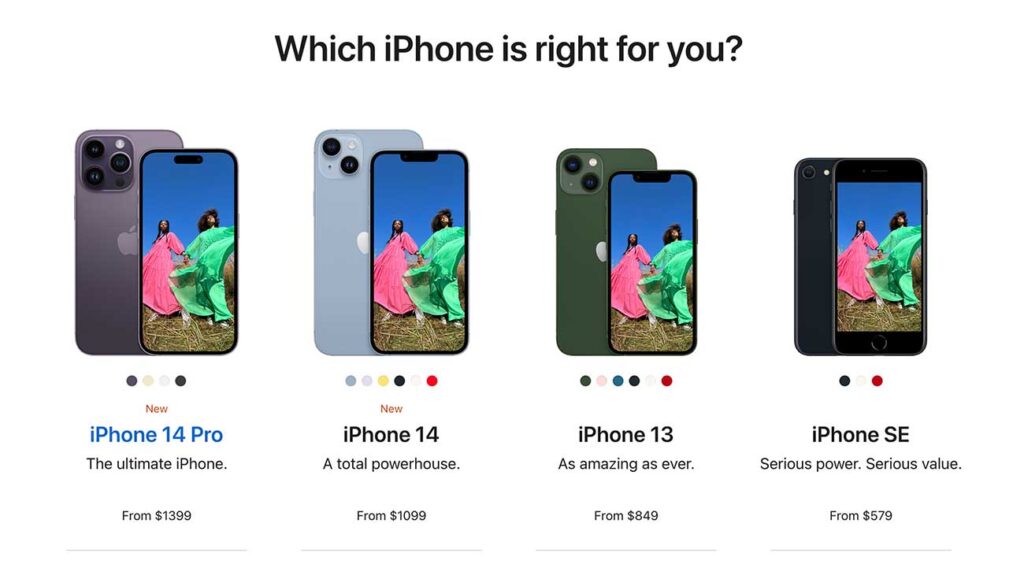
After six years with an older model iPhone, I finally decided to upgrade recently. Apple uses price bracketing on a rolling basis with all of their older models slowly becoming cheaper and separates their newest models into a base category and a “Pro” category. The prices reflect their age and status clearly, making their value perceivable by price alone.
– Scott Williamson
Why use this tactic?
By using the price bracketing pricing strategy, a Shopify store can take advantage of the anchoring effect and make their products more appealing to customers.
Discounts and Promotions
Discounts and promotions can be effective pricing strategies for e-commerce and Shopify stores. Offering discounts or promotions can make consumers feel like they are getting a better deal, even if the actual price is higher than the competition. For example, offering a 10% discount on a $100 product can make customers feel like they are getting a great deal, even though the final price is still $90.
Examples
A Shopify store could offer a limited-time discount to encourage customers to make a purchase. For example, the store could offer a 10% discount on all products for a week. This can create a sense of urgency in customers, making them more likely to make a purchase before the promotion ends. Additionally, the store could offer a discount code to customers who sign up for their email list or follow them on social media. By doing this, the store can encourage customer loyalty and increase the chances of making repeat sales.
I love shooting film and at a local camera store I often visit, they employ one of the most common promotions employed by merchants: a rewards program. For every 10 rolls of film I develop, I get one free. Because of this, I feel incentivized to continue using their service in order to get my “free” service later on. Merchants often think of discounts or promotions on a short-term basis, but long-term programs or memberships can be even more powerful and help you build a loyal customer base.
– Scott Williamson
Why use this tactic?
By using discounts and promotions as a pricing strategy, a Shopify store can make their products more appealing to customers and increase their chances of making a sale.
The Power of Free
The power of free is a pricing strategy that involves offering a product or service for free to attract customers. This pricing strategy can be effective because customers are more likely to try a product or service if they do not have to pay for it.
TIP: Shopify merchants often underestimate the advantage of including free products on their shop. If customers see products which are free they are more likely to add them to their cart, and this will likely encourage them to add additional items to their cart. It’s also a good way to offer free trials, or samples, getting a customer for the cost of the free sample into your customer database can create long term value for your shop.
– John Speed
Examples
For example, a Shopify store could offer a free trial of their product or service to encourage customers to try it out. By doing this, the store can give customers a taste of what they have to offer and increase the chances of making a sale.
Additionally, the store could offer a free product or service as a promotional item to customers who make a purchase over a certain amount. This can create a sense of goodwill with customers and encourage them to make future purchases.
I’ve felt the power of free personally as I’ve helped hundreds of Benjamin Moore paint stores open stores on Shopify, which include a library of available colours with free samples. By offering them for free the stores are able to establish a relationship with the customer with less friction and ultimately help allow them to make a purchase decision.
– John Speed
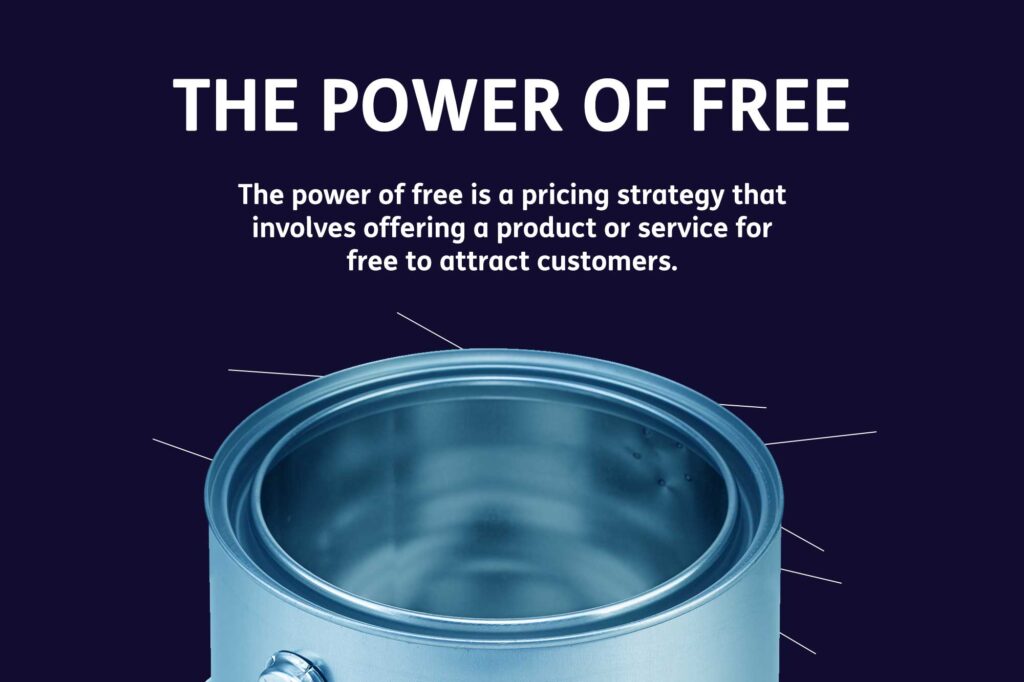
Why use this tactic?
By using the power of free as a pricing strategy, a Shopify store can attract new customers and increase the chances of making a sale.
Pay What You Want Pricing
Pay what you want pricing is a pricing strategy that allows customers to pay whatever they want for a product or service. It’s also known as Make an Offer, or Best Offer pricing.
This unconventional pricing model has been used in the music and entertainment industries, where fans are often given the option to pay what they want for an album or concert ticket. Pay what you want pricing can also be used in e-commerce and Shopify stores to attract customers and increase sales.
Why use this tactic?
One of the most significant advantages of pay what you want pricing is that it creates a sense of goodwill with customers. When customers are given the freedom to choose their own price, they often feel like they are receiving a good deal and that the company is being generous. This can lead to increased customer satisfaction and loyalty, as customers are more likely to return to the business in the future.
Furthermore, pay what you want pricing can also increase the perceived value of a product or service. When customers are given the freedom to determine their own price, they are more likely to feel like they are getting a fair deal and that the product or service is worth the price they pay. This can lead to increased sales and profits for businesses.
I worked with a client who was selling shoes online, a really interesting Italian guy. His shoes were used as materials in large scale art installation. The shoes were sold for a ‘pay what you want’ price. I thought he was crazy.
– John Speed
However, pay what you want pricing can also be risky for businesses. Customers may not be willing to pay enough to cover the cost of production or the desired profit margin. Therefore, some businesses use a hybrid pricing strategy that allows customers to pay what they want, but with a minimum price set by the company. This can ensure that the company is making a profit while still allowing customers to feel like they have control over the price they pay.
In summary, pay what you want pricing can be an effective pricing strategy for businesses that want to build customer loyalty and create a sense of goodwill with their customers. However, it is important to carefully consider the potential risks and benefits before implementing this pricing strategy.
How to implement it
Pay what you want pricing can be a particularly effective pricing strategy for Shopify stores. Shopify offers a variety of apps that allow businesses to implement this pricing model easily using an app like Magical Make an Offer. These apps can help businesses to set a minimum price for their products or services, ensuring that they are making a profit while still allowing customers to choose their own price.
Add-On Pricing
Add-on pricing is a pricing strategy that involves offering additional products or services for an additional fee. This strategy is effective because it allows customers to customize their purchase to meet their specific needs and preferences.
It is important to note that add-on pricing should be used carefully to avoid creating customer frustration or resentment. Customers may feel like they are being “nickel and dimed” if too many add-on services are offered, or if the prices for add-on services are too high. Therefore, it is important to carefully consider the pricing and value of add-on services before implementing this pricing strategy.
Examples
For example, a Shopify store could offer add-on services such as gift wrapping, expedited shipping, or a warranty for an additional fee.
Add-on pricing can also be used for product or service fees like tax, mandatory fees, or eco fees. For example, a Shopify store selling electronics may charge an additional fee to cover the cost of disposing of electronic waste. Similarly, a store selling products in Europe may need to charge a value-added tax (VAT) on top of the sale price. By offering add-on pricing for these types of fees, the Shopify store can ensure that they are covering their costs while still providing customers with a transparent and fair pricing structure.
Why use this tactic?
This can increase the perceived value of the product or service and encourage customers to make a purchase. Additionally, offering add-on services can help the store generate additional revenue and increase profits.
Whacky pricing strategies to attract customers on Shopify.
The pay what you want model
In 2007, the band Radiohead released their album In Rainbows and allowed fans to pay whatever they wanted for the digital download. This pricing model was groundbreaking for the music industry and received a lot of attention. This youtube video is a pretty good watch and it outlines everything really well. Check it out.
Dynamic pricing
Airlines and hotels have been using dynamic pricing for years, but it’s becoming more common in other industries as well. This pricing model involves adjusting prices based on factors such as demand, time of day, or even the user’s browsing history
Bundles and Unbundles
Bundles and unbundles are a pricing strategy that involves combining or separating products or services to create a more appealing offer for customers.
This strategy can be used in e-commerce and Shopify stores to encourage customers to make a purchase by offering them a deal that is too good to pass up.
One example of a company that has successfully used bundle pricing is AirAsia. In 2018, they launched a new route from Kuala Lumpur, Malaysia to Honolulu, Hawaii with a promotional price of just $99. However, the $99 fare did not include checked baggage, meals, or in-flight entertainment. Instead, passengers had to purchase a separate bundle of add-ons for $199 that included a checked bag, a meal, and in-flight entertainment. Essentially, passengers were paying $298 for a round-trip ticket, which was still a great deal for a flight from Malaysia to Hawaii. While some passengers may have been put off by the additional cost of the add-on bundle, others appreciated the ability to customize their experience and only pay for the services they actually wanted.
Overall, AirAsia’s bundle pricing strategy was a bold move that paid off, allowing the airline to offer an incredibly low fare while still making a profit. While some passengers may have been put off by the additional cost of the add-on bundle, others may have appreciated the ability to customize their experience and only pay for the services they actually wanted. Overall, AirAsia’s whacky pricing strategy was a bold move that paid off, allowing the airline to offer an incredibly low fare while still making a profit.
Free Samples
One example of a company that has had success using free samples to promote their products is Sephora. They offer a variety of free samples to customers who visit their stores or make a purchase online. By allowing customers to try products before committing to a purchase, Sephora has been able to build customer loyalty and increase sales. Additionally, the free samples allow customers to discover new products they may not have otherwise tried, further increasing sales for Sephora.
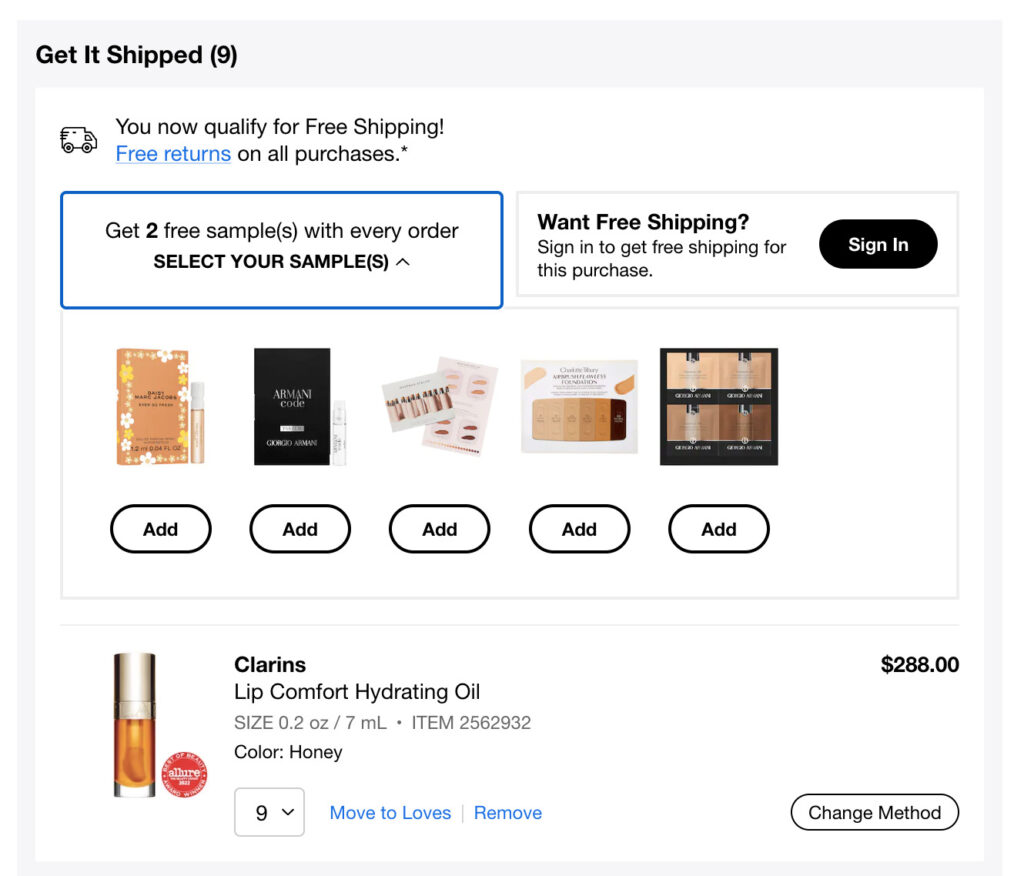
While these pricing strategies may seem unconventional, they have been effective in attracting customers and increasing sales for many companies.
Quick takeaways
Pricing psychology is a crucial aspect of e-commerce and Shopify stores that can significantly impact a business’s success.
By understanding the principles of pricing psychology, businesses can set prices that are more appealing to consumers and increase their chances of making a sale. From the power of numbers to the anchoring effect and the importance of context, there are many strategies that businesses can use to set prices effectively.
By implementing these strategies, businesses can optimize their pricing strategy and improve their bottom line. However, it is important to note that pricing psychology is just one aspect of a successful e-commerce or Shopify store. Other factors, such as product quality, customer service, and marketing, are also essential for success.
Here is a summary of the main points from this article on pricing psychology for e-commerce and Shopify stores:
- Pricing is one of the most crucial factors for any business, including e-commerce and Shopify stores.
- One of the most important factors for pricing is pricing psychology, which studies how consumers perceive prices and how those perceptions affect their purchasing decisions.
- Pricing Psychology Strategies to use for Shopify Pricing
- Perception of value
- The power of numbers
- The anchoring effect
- The scarcity effect
- Charm pricing
- Odd pricing
- Price bracketing
- Context
- Discounts and promotions
- Decoy effect
- Other factors that go into pricing include the cost of production, marketing and advertising expenses, competition, target market, and desired profit margin.
- By understanding and implementing effective pricing strategies, businesses can set prices that are more appealing to consumers and increase their chances of making a sale.
- However, it is important to note that pricing psychology is just one aspect of a successful e-commerce or Shopify store. Other factors, such as product quality, customer service, and marketing, are also essential for success.
I hope this article was helpful for you. Setting your pricing strategy can feel complicated but it’s important to take things one step at a time. The Shopify App store also has a range of apps designed to help you manage your sale prices, or help you generate more sales by allowing customers to set their own price.
About the author
This article was created by John Speed. John has spent the past 20+ years working in marketing, design, website development and Shopify App development roles. He’s currently focused on designing and developing Websites and Shopify apps which help merchants sell more products on Shopify.
Magical Make an Offer
Use the Magical Make an Offer app to sell more products. Easily add Make an Offer and Pay What you Want buttons to products.